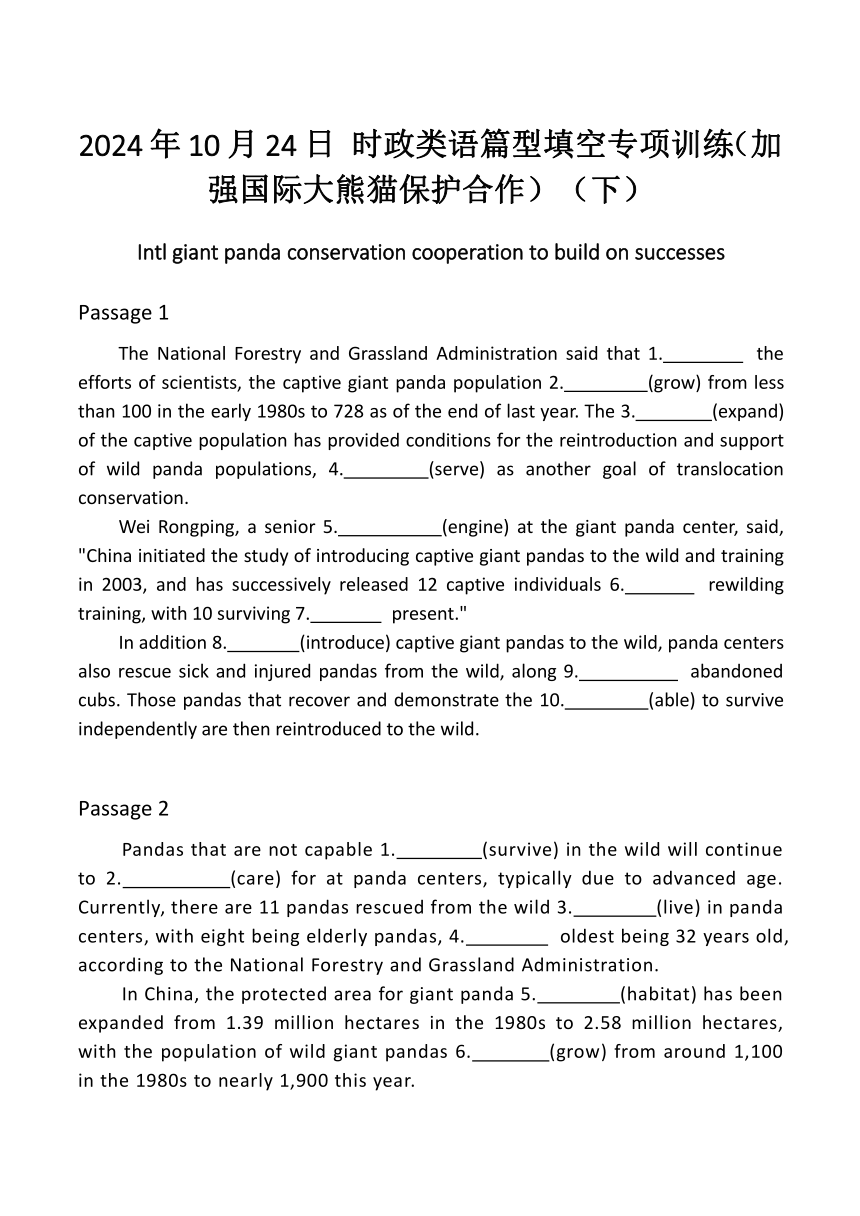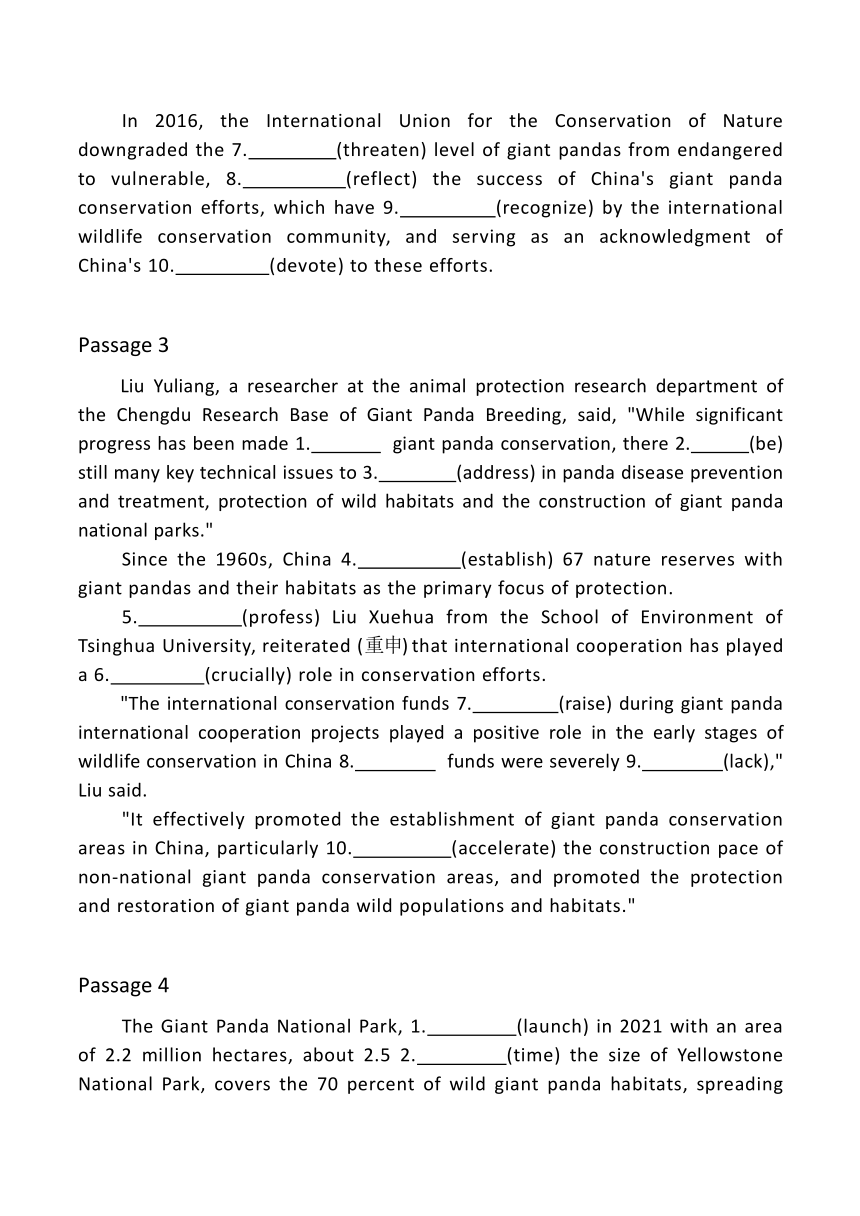2024年10月24日 时政类语篇型填空专项训练(加强国际大熊猫保护合作)(下)(4篇,含答案与译文)-2025届高三英语复习专项
文档属性
| 名称 | 2024年10月24日 时政类语篇型填空专项训练(加强国际大熊猫保护合作)(下)(4篇,含答案与译文)-2025届高三英语复习专项 |  | |
| 格式 | docx | ||
| 文件大小 | 28.3KB | ||
| 资源类型 | 教案 | ||
| 版本资源 | 人教版(2019) | ||
| 科目 | 英语 | ||
| 更新时间 | 2025-01-17 13:01:40 | ||
图片预览


文档简介
2024年10月24日 时政类语篇型填空专项训练(加强国际大熊猫保护合作)(下)
Intl giant panda conservation cooperation to build on successes
Passage 1
The National Forestry and Grassland Administration said that 1. the efforts of scientists, the captive giant panda population 2. (grow) from less than 100 in the early 1980s to 728 as of the end of last year. The 3. (expand) of the captive population has provided conditions for the reintroduction and support of wild panda populations, 4. (serve) as another goal of translocation conservation.
Wei Rongping, a senior 5. (engine) at the giant panda center, said, "China initiated the study of introducing captive giant pandas to the wild and training in 2003, and has successively released 12 captive individuals 6. rewilding training, with 10 surviving 7. present."
In addition 8. (introduce) captive giant pandas to the wild, panda centers also rescue sick and injured pandas from the wild, along 9. abandoned cubs. Those pandas that recover and demonstrate the 10. (able) to survive independently are then reintroduced to the wild.
Passage 2
Pandas that are not capable 1. (survive) in the wild will continue to 2. (care) for at panda centers, typically due to advanced age. Currently, there are 11 pandas rescued from the wild 3. (live) in panda centers, with eight being elderly pandas, 4. oldest being 32 years old, according to the National Forestry and Grassland Administration.
In China, the protected area for giant panda 5. (habitat) has been expanded from 1.39 million hectares in the 1980s to 2.58 million hectares, with the population of wild giant pandas 6. (grow) from around 1,100 in the 1980s to nearly 1,900 this year.
In 2016, the International Union for the Conservation of Nature downgraded the 7. (threaten) level of giant pandas from endangered to vulnerable, 8. (reflect) the success of China's giant panda conservation efforts, which have 9. (recognize) by the international wildlife conservation community, and serving as an acknowledgment of China's 10. (devote) to these efforts.
Passage 3
Liu Yuliang, a researcher at the animal protection research department of the Chengdu Research Base of Giant Panda Breeding, said, "While significant progress has been made 1. giant panda conservation, there 2. (be) still many key technical issues to 3. (address) in panda disease prevention and treatment, protection of wild habitats and the construction of giant panda national parks."
Since the 1960s, China 4. (establish) 67 nature reserves with giant pandas and their habitats as the primary focus of protection.
5. (profess) Liu Xuehua from the School of Environment of Tsinghua University, reiterated (重申) that international cooperation has played a 6. (crucially) role in conservation efforts.
"The international conservation funds 7. (raise) during giant panda international cooperation projects played a positive role in the early stages of wildlife conservation in China 8. funds were severely 9. (lack)," Liu said.
"It effectively promoted the establishment of giant panda conservation areas in China, particularly 10. (accelerate) the construction pace of non-national giant panda conservation areas, and promoted the protection and restoration of giant panda wild populations and habitats."
Passage 4
The Giant Panda National Park, 1. (launch) in 2021 with an area of 2.2 million hectares, about 2.5 2. (time) the size of Yellowstone National Park, covers the 70 percent of wild giant panda habitats, spreading through the provinces of Sichuan, Shaanxi and Gansu.
The national park 3. (connect) 13 local populations through ecological corridors.
In Sichuan province 4. , there are more than 7,800 infrared camera monitoring points set 5. , having collected over 7.3 million pieces of data, according to the Sichuan forestry and grassland bureau.
Chen Zongqian, deputy 6. (direct) of the bureau, said, "We have recorded 32 instances of giant panda 7. (act) in key ecological corridor restoration areas such as Tuowu Mountain, Niba Mountain and Erlang Mountain. 8. number of giant pandas in these 9. (prior) areas has increased by 50, and the annual encounter rate of wild giant pandas 10. (rise) from 178 to 185."
参考答案
参考答案1
1.through 2.has grown 3.expansion 4.serving 5.engineer
6.after 7.at 8. to introducing 9.with 10.ability
参考译文1
国家林业和草原局表示,通过科学家的努力,圈养大熊猫的数量已从20世纪80年代初的不到100只增加到去年年底的728只。圈养种群的扩大为野生大熊猫种群的重新引入和支持提供了条件,是易地保护的另一个目标。
大熊猫中心的高级工程师魏荣平说:“中国在2003年开始了将圈养大熊猫引入野外和训练的研究,并在重新野化训练后陆续释放了12只圈养大熊猫,目前有10只存活。”
除了将圈养大熊猫引入野外,大熊猫中心还从野外拯救生病和受伤的大熊猫,以及被遗弃的幼崽。那些恢复并表现出独立生存能力的大熊猫将被重新引入野外。
参考答案2
1.of surviving 2.be cared 3.living 4.the 5.habitats
6.growing 7.threat 8.reflecting 9.been recognized 10.devotion
参考译文2
无法在野外生存的大熊猫将继续在大熊猫中心得到照顾,通常是由于高龄。据国家林业和草原局称,目前,有11只大熊猫从野外获救,生活在大熊猫中心,其中8只是老年大熊猫,最大的已经32岁了。
在中国,大熊猫栖息地的保护区已经从20世纪80年代的139万公顷扩大到258万公顷,野生大熊猫的数量从20世纪80年代的1100只左右增加到今年的近1900只。
2016年,国际自然保护联盟(iucn)将大熊猫的濒危程度从濒危降至易危,这反映了中国大熊猫保护工作的成功,得到了国际野生动物保护界的认可,也是对中国努力的肯定。
参考答案3
1.in 2.are 3.be addressed 4.has established 5.Professor
6.crucial 7.raised 8.when 9.lacking 10.accelerating
参考译文3
成都大熊猫繁育研究基地动物保护研究部门的研究员刘玉良说:“虽然大熊猫保护取得了重大进展,但在熊猫疾病的预防和治疗、野生栖息地的保护和大熊猫国家公园的建设方面仍有许多关键的技术问题需要解决。”
自20世纪60年代以来,中国已建立了67个自然保护区,以大熊猫及其栖息地为重点保护对象。
清华大学环境学院刘雪华教授重申,国际合作在保护工作中发挥了至关重要的作用。
“在大熊猫国际合作项目中筹集的国际保护基金在中国野生动物保护的早期阶段发挥了积极作用,当时资金严重缺乏,”刘说。
“它有效地推动了中国大熊猫保护区的建立,特别是加快了非国家级大熊猫保护区的建设步伐,促进了大熊猫野生种群和栖息地的保护和恢复。”
参考答案4
1.launched 2.times 3.connects 4.alone 5.up
6.director 7.activity 8.The 9.priority 10.has risen
参考译文4
大熊猫国家公园于2021年启动,占地220万公顷,约为黄石国家公园的2.5倍,覆盖了70%的野生大熊猫栖息地,分布在四川、陕西和甘肃三省。
国家公园通过生态走廊连接了13个当地居民。
据四川省林业和草原局称,仅在四川省,就建立了7800多个红外摄像机监测点,收集了730多万份数据。
该局副局长陈宗谦说:“我们已经记录了32例大熊猫活动,这些活动发生在重要的生态走廊恢复地区,如托武山、尼巴山和二郎山。这些重点区域的大熊猫数量增加了50只,野生大熊猫的年偶遇率从178只上升到185只。”
Intl giant panda conservation cooperation to build on successes
Passage 1
The National Forestry and Grassland Administration said that 1. the efforts of scientists, the captive giant panda population 2. (grow) from less than 100 in the early 1980s to 728 as of the end of last year. The 3. (expand) of the captive population has provided conditions for the reintroduction and support of wild panda populations, 4. (serve) as another goal of translocation conservation.
Wei Rongping, a senior 5. (engine) at the giant panda center, said, "China initiated the study of introducing captive giant pandas to the wild and training in 2003, and has successively released 12 captive individuals 6. rewilding training, with 10 surviving 7. present."
In addition 8. (introduce) captive giant pandas to the wild, panda centers also rescue sick and injured pandas from the wild, along 9. abandoned cubs. Those pandas that recover and demonstrate the 10. (able) to survive independently are then reintroduced to the wild.
Passage 2
Pandas that are not capable 1. (survive) in the wild will continue to 2. (care) for at panda centers, typically due to advanced age. Currently, there are 11 pandas rescued from the wild 3. (live) in panda centers, with eight being elderly pandas, 4. oldest being 32 years old, according to the National Forestry and Grassland Administration.
In China, the protected area for giant panda 5. (habitat) has been expanded from 1.39 million hectares in the 1980s to 2.58 million hectares, with the population of wild giant pandas 6. (grow) from around 1,100 in the 1980s to nearly 1,900 this year.
In 2016, the International Union for the Conservation of Nature downgraded the 7. (threaten) level of giant pandas from endangered to vulnerable, 8. (reflect) the success of China's giant panda conservation efforts, which have 9. (recognize) by the international wildlife conservation community, and serving as an acknowledgment of China's 10. (devote) to these efforts.
Passage 3
Liu Yuliang, a researcher at the animal protection research department of the Chengdu Research Base of Giant Panda Breeding, said, "While significant progress has been made 1. giant panda conservation, there 2. (be) still many key technical issues to 3. (address) in panda disease prevention and treatment, protection of wild habitats and the construction of giant panda national parks."
Since the 1960s, China 4. (establish) 67 nature reserves with giant pandas and their habitats as the primary focus of protection.
5. (profess) Liu Xuehua from the School of Environment of Tsinghua University, reiterated (重申) that international cooperation has played a 6. (crucially) role in conservation efforts.
"The international conservation funds 7. (raise) during giant panda international cooperation projects played a positive role in the early stages of wildlife conservation in China 8. funds were severely 9. (lack)," Liu said.
"It effectively promoted the establishment of giant panda conservation areas in China, particularly 10. (accelerate) the construction pace of non-national giant panda conservation areas, and promoted the protection and restoration of giant panda wild populations and habitats."
Passage 4
The Giant Panda National Park, 1. (launch) in 2021 with an area of 2.2 million hectares, about 2.5 2. (time) the size of Yellowstone National Park, covers the 70 percent of wild giant panda habitats, spreading through the provinces of Sichuan, Shaanxi and Gansu.
The national park 3. (connect) 13 local populations through ecological corridors.
In Sichuan province 4. , there are more than 7,800 infrared camera monitoring points set 5. , having collected over 7.3 million pieces of data, according to the Sichuan forestry and grassland bureau.
Chen Zongqian, deputy 6. (direct) of the bureau, said, "We have recorded 32 instances of giant panda 7. (act) in key ecological corridor restoration areas such as Tuowu Mountain, Niba Mountain and Erlang Mountain. 8. number of giant pandas in these 9. (prior) areas has increased by 50, and the annual encounter rate of wild giant pandas 10. (rise) from 178 to 185."
参考答案
参考答案1
1.through 2.has grown 3.expansion 4.serving 5.engineer
6.after 7.at 8. to introducing 9.with 10.ability
参考译文1
国家林业和草原局表示,通过科学家的努力,圈养大熊猫的数量已从20世纪80年代初的不到100只增加到去年年底的728只。圈养种群的扩大为野生大熊猫种群的重新引入和支持提供了条件,是易地保护的另一个目标。
大熊猫中心的高级工程师魏荣平说:“中国在2003年开始了将圈养大熊猫引入野外和训练的研究,并在重新野化训练后陆续释放了12只圈养大熊猫,目前有10只存活。”
除了将圈养大熊猫引入野外,大熊猫中心还从野外拯救生病和受伤的大熊猫,以及被遗弃的幼崽。那些恢复并表现出独立生存能力的大熊猫将被重新引入野外。
参考答案2
1.of surviving 2.be cared 3.living 4.the 5.habitats
6.growing 7.threat 8.reflecting 9.been recognized 10.devotion
参考译文2
无法在野外生存的大熊猫将继续在大熊猫中心得到照顾,通常是由于高龄。据国家林业和草原局称,目前,有11只大熊猫从野外获救,生活在大熊猫中心,其中8只是老年大熊猫,最大的已经32岁了。
在中国,大熊猫栖息地的保护区已经从20世纪80年代的139万公顷扩大到258万公顷,野生大熊猫的数量从20世纪80年代的1100只左右增加到今年的近1900只。
2016年,国际自然保护联盟(iucn)将大熊猫的濒危程度从濒危降至易危,这反映了中国大熊猫保护工作的成功,得到了国际野生动物保护界的认可,也是对中国努力的肯定。
参考答案3
1.in 2.are 3.be addressed 4.has established 5.Professor
6.crucial 7.raised 8.when 9.lacking 10.accelerating
参考译文3
成都大熊猫繁育研究基地动物保护研究部门的研究员刘玉良说:“虽然大熊猫保护取得了重大进展,但在熊猫疾病的预防和治疗、野生栖息地的保护和大熊猫国家公园的建设方面仍有许多关键的技术问题需要解决。”
自20世纪60年代以来,中国已建立了67个自然保护区,以大熊猫及其栖息地为重点保护对象。
清华大学环境学院刘雪华教授重申,国际合作在保护工作中发挥了至关重要的作用。
“在大熊猫国际合作项目中筹集的国际保护基金在中国野生动物保护的早期阶段发挥了积极作用,当时资金严重缺乏,”刘说。
“它有效地推动了中国大熊猫保护区的建立,特别是加快了非国家级大熊猫保护区的建设步伐,促进了大熊猫野生种群和栖息地的保护和恢复。”
参考答案4
1.launched 2.times 3.connects 4.alone 5.up
6.director 7.activity 8.The 9.priority 10.has risen
参考译文4
大熊猫国家公园于2021年启动,占地220万公顷,约为黄石国家公园的2.5倍,覆盖了70%的野生大熊猫栖息地,分布在四川、陕西和甘肃三省。
国家公园通过生态走廊连接了13个当地居民。
据四川省林业和草原局称,仅在四川省,就建立了7800多个红外摄像机监测点,收集了730多万份数据。
该局副局长陈宗谦说:“我们已经记录了32例大熊猫活动,这些活动发生在重要的生态走廊恢复地区,如托武山、尼巴山和二郎山。这些重点区域的大熊猫数量增加了50只,野生大熊猫的年偶遇率从178只上升到185只。”
